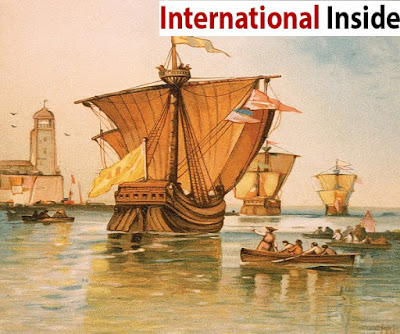Christopher Columbus – Hero or Villain?
Christopher Columbus, that Portuguese explorer who is credited with discovering America, is a person that elicits very different images depending on where you come from. To some, he is the very epitome of an intrepid explorer and a hero of the Spanish people, but to others, he is the person responsible for the decimation of the indigenous peoples of South America. So who is he?
Early life
According to International Inside, Columbus was born in the middle of the 15th Century to a wool merchant, Domenico Colombo, and his wife, Susanna Fontanarossa. He had brothers, Giovanni Pellegrino, Bartolomeo, and Giacomo and a sister named Bianchinetta.
In his early life, he sailed with the Portuguese merchant marine until 1470. After being attacked by pirates, he gave up the sea, and he moved to Lisbon, where he studied astronomy, cartography, mathematics, and navigation. On completing his studies, he and his brother, Bartolomeo, worked as mapmakers until the sea called once again and he returned to sailing.
Western Sea Route
Towards the end of the 1400s, it was dangerous to travel to Asia from Europe, via a land route. The route was blocked in many places by hostile peoples, and the only safe way to travel to Asia and buy spices and other lucrative trade goods was to go by sea. European sailors sailed down the coast of Africa and around the Cape of Good Hope and then up the eastern coast of Africa to arrive in Asia.
This was a long, arduous and dangerous journey, and Columbus was besotted with the idea that he could sail west from Europe, across the Atlantic Ocean, and find a route to Asia, that way.
For many years he tried to convince businessmen in both England and Portugal of the validity of this plan, with no success. Eventually, in 1491 he managed to convince the royal court of Spain to sponsor a voyage for him to go west. The Spanish King Ferdinand and Queen Isabella were both devout Catholics and not only were they interested in the wealth to be made trading with Asia, but they hoped to export Catholicism to all parts of the world. The court decreed that Columbus would keep ten percent of the wealth he found as well as being granted a royal title and becoming governor of his region of choice, should he be successful in finding his westward passage.
Columbus finds the Caribbean
Columbus undertook three voyages between 1492 and 1503. All of these voyages were sponsored by the Royal court of Spain, and they were all between Europe and, what is today known as the Caribbean. He was absolutely sure that he had reached Asia, even though many disputed his claims.
On the last of these three voyages, he actually landed on the South American continent, at the mouth of the Orinoco River.
After this voyage, he was arrested and returned to Spain as his enemies had convinced the court that he and his brothers had broken any laws.
In 1502, a very sickly, Columbus made one final voyage on behalf of the crown, but on December 1502 he had to abandon two of his ships in Panama, after a violent storm. His last two ships ran aground in Jamaica on June 1503. He and his crew had to wait a year to be rescued. He returned to Spain, where he died on 20 May 1506.
Hero or villain?
It seems that Columbus was a bit of both.
He was indeed a notable mariner, and he did push the boundaries of the known world far to the west, but how he governed these Caribbean islands left much to be desired.
He is also blamed for the decimation of the indigenous people due to the diseases carried by the settlers and sailors, to which the local people had no resistance. This is a little unfair as, at that time, the causes of disease were not known, and he would have had no idea that the germs carried by his people would have such a devastating effect.
As with most things, there is no easy answer and how you view this man will depend upon the prism of your own life.



Comments
Post a Comment